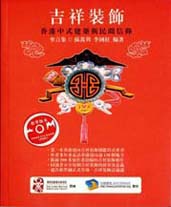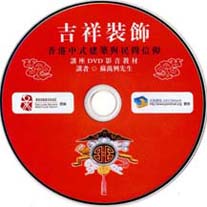Projects
Production, Publication and Promotion of “Relationship between Ornaments on Vernacular Architecture in Hong Kong and the Traditional Customs”
Year of Approval
2008-2009
Grantee
Mr SO Man-hing
Project Status
Completed in February 2010
Brief Description of the Project
Walking into some of the old buildings in Hong Kong, such as vernacular houses, study halls, ancestral halls and temples, one can often see wood, clay and porcelain carvings of auspicious ornaments on ridges, gables, brackets sets and beams. One can also discover similar ornaments in the shapes of dragons, phoenixes, Chinese unicorns, and lions in urban buildings. These auspicious ornaments are traditional folk arts that mirror the rural life and religious beliefs of Chinese people. They also represent people’s respect for the gods and the ancestors, as well as their aspiration for a good life.
Mr So Man-hing was granted funding support by the Lord Wilson Heritage Trust to publish a book named “Relationship between Ornaments on Vernacular Architecture in Hong Kong and the Traditional Customs”. He took photos of auspicious ornaments around Hong Kong, recorded their locations and captioned all photos so that readers may follow in his footsteps to explore and appreciate the artistic and cultural value of these buildings.
With the funding support from the Trust, Mr So also organised site visits and guided tours for the elderly, students and persons with disabilities to understand Chinese culture and local heritage as contained in the auspicious ornaments of vernacular architecture.
Project Deliverable(s)
The Project deliverables included:
(a) Talk/Lecture
Talk
http://www.youtube.com/watch?v=MNhyhbyqCD0
http://www.youtube.com/watch?v=aOC3Gr-C1y8
http://www.youtube.com/watch?v=bHkY4xQv1sI
http://www.youtube.com/watch?v=2IqYLC0KXF8
http://www.youtube.com/watch?v=n4XBEZpStW4
http://www.youtube.com/watch?v=f_NRjNf95MA
A Hundred Birds Paying Respect to the Phoenix Sha Tau Kok Tang’s Ancestral Hall (above)/Stanley Tin Hau Temple (below)
Feng-huang, or Phoenix, is also referred to as the “bird with red feathers” and reigns over all birds. Ancient people see phoenix as a symbol of benevolence, righteousness and auspiciousness. Before the Qin dynasty, phoenix represents peace and prosperity. Feng or the male bird represents the emperor, while Huang or the female bird represents the queen. During the Ming and Qing dynasties, the imagery of “two phoenixes flying towards the sun” symbolised the wish for students to succeed in examinations and have a successful career as government officials. The myth that phoenix only perches on treasure gives rises to the saying that “a phoenix comes to rest is a sign of good fortune”.
Pig
Hau Ku Shek Ancestral Hall (above)/ Yuen Long Pun Uk (below)
Pig is one of the six livestock, a kind, gentle and clever animal. Ancient people changed their attitudes towards wild hogs from fear to reverence and eventually turned them into mythical creatures with the power of chasing away evil spirits and turning bad luck into good fortune. The Chinese character for home (家) shows a pig beneath a roof, which demonstrates just how important are pigs to Chinese families. Ancient rural society believed that no homes should do without a pig which went on to become a symbol of wealth and auspiciousness.
Good Fortune before Your Eyes
Sha Tau Kok Yau’s Ancestral Hall (above)/Taipo Lam’s Ancestral Hall (below)
The bat is a symbol of good fortune. The five bats in the picture stand for five blessings. According to the Book of Document (Shang Shu), one of five Chinese classics, the five blessings are longevity, wealth, health, love of virtue and a natural death.
The bat is a symbol of good fortune. The five bats in the picture stand for five blessings. According to the Book of Document (Shang Shu), one of five Chinese classics, the five blessings are longevity, wealth, health, love of virtue and a natural death.
Good Fortune, Wealth and Longevity
Tai Hang Man’s Ancestral Hall
This is an amalgam of different symbols. The bat (having the same pronunciation as “good fortune” in Chinese) at the top represents good fortune. Right in the middle is a symbol of longevity. Sticking out the middle on both sides are flaps of the hat worn by government officials, representing wealth. At the bottom is a Chinese coin representing money. Together they bring good fortune, wealth and longevity.
Fame, Wealth and Prestige
Lung Yeuk Tau Kan Lung Wai
“Cock” is homonymic with “auspiciousness” in Chinese. When a cock crows, as depicted in the relief, it symbolizes “fame”. The flowers in the back are peonies, which represent “wealth and prestige”. Putting them together and we get “fame, wealth and prestige”.
Auspicious Objects for Driving Out the Evil Spirits
Tai Hang Man’s Ancestral Hall
Ancestral halls often have auspicious objects hanging on the main beams to drive away evil spirits and to ensure the safety of future generations. Different objects symbolize different meanings. As shown in Man’s Ancestral Hall, from left to right:
- Leaves of pine, cypress and citrus maxima: Auspiciousness.
- Lantern: A source of brilliant light to bring fertility, wealth, prestige and longevity.
- Red and green pouches: They are filled with rice, red and green beans, grains and peanuts to symbolize having good harvests.
- A red cloth and a green cloth: They symbolize the presence of great-grandparents to greet the guests and look after their offspring. They may also symbolize fame and wealth or health and prosperity.
- Small mirror on red cloth: A device to cast vile characters out the door.
- Sieve: A device to turn away vile characters.
Related Link(s)
(1) Relationship between Ornaments on Vernacular Architecture in Hong Kong and the Traditional Customs
(2) Lord Wilson Heritage Trust: Ornaments on Vernacular Architecture in Hong Kong







